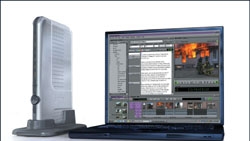DV production systems
Digital video (DV) is quickly becoming the preferred format for ENG, current affairs and low-budget documentaries, while it is beginning to make in-roads into high-end drama and documentaries and even in feature film productions. What are the reasons behind this success story? Are there limitations to be considered?

A DV editing software package should give the editor all of the control necessary to make the most out of DV material. Avid’s Xpress Pro, for example, offers a fully integrated set of tools, including color correction tools.
The advantage of FireWire
If you are using a nonlinear video editing system, there is less need for expensive digitizing hardware because the DV signal can be transferred directly from tape to disk via the standard FireWire (IEEE1394) interface that is available on most DV cameras and decks. There are editing systems that work entirely in software without the need for any hardware, using the FireWire connector that is now standard in many computer workstations and laptops. In addition, using a FireWire connector allows the material to be transferred in its native format, thus completely preserving the picture quality.
DV specifications
DV is a digital video format that uses two types of compression. The first is a reduction of the color information. A fully digitized color signal would be characterized as 4:4:4, with luminance and chroma information being sampled in equal amounts. DV uses sampling schemes of 4:1:1 or 4:2:0, effectively sampling only a quarter of the chroma information.
The second compression is an MPEG-style temporal compression, which results in an overall 5:1 compression or a data rate of 25Mb/s, hence the term DV25. A DV50 format, at the higher rate of 50Mb/s, is being promoted by some camera and deck manufacturers, but it has had limited uptake so far in the industry.
Within the DV25 video format, there are three types of tape standard. MiniDV was the original standard. Initially designed as a consumer format, its low tape speed and a limited control track mechanism resulted in small tapes with long playing times. Paradoxically, MiniDV is used extensively in broadcast, mainly because of the small size of the cameras and decks that support it. It is ideal for news teams or for the increasing amount of investigative journalism with hidden cameras.
A professional version is DVCAM. With higher tape speeds, locked audio and video, and the ability to stripe tapes, it has all the tools for professional use. The final format is DVCPRO, solely manufactured by Panasonic. It uses a different tape format, but its features are similar to DVCAM.
Get the TV Tech Newsletter
The professional video industry's #1 source for news, trends and product and tech information. Sign up below.
MiniDV and DVCAM have an identical data format in that they use 4:2:0 color sampling, but DVCAM recorders need to see a “locked audio” flag when they capture digitally. DVCPRO uses 4:1:1 color sampling and is incompatible with the former two formats. To remain flexible, therefore, it is essential that your editing system is capable of working with all three formats — either being able to deal with all three formats separately, or even able to convert between the formats in real-time.
Maintaining quality
DV may be low-budget, but the entire post-production process should be kept as high-quality as possible. An important aspect is the ability to completely finish a program within the editing system. With the limited budgets available, DV producers do not always have the luxury of using a separate finishing suite.
More and more, the complete production must be finished on location, such as in the journalist’s hotel room. As a result, it is preferable to have all the required tools for editing, creating effects and graphics, and audio mixing available within the same system, rather than a potpourri of software modules that may or may not work together.
Real-time effects
With faster computers and dedicated software design, it is possible to preview many standard effects in real-time without additional hardware, allowing the editor to concentrate on the creative aspects of the job.
If real-time effects are to be displayed on a standard video monitor, a hardware unit can be connected to the FireWire port. This provides the DV editing system with analog video I/O and allows for all real-time effects to be played out, in full resolution, to an external monitor or back to tape.
Hans Venmans is senior product marketing manager - editing solutions for Avid Technology Europe.
